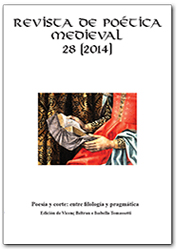«Cancioneros plurilingües en el Nápoles español: ‘Versos de Juan de la Vega’ (Mattia Cancer, 1552)»
DOI:
https://doi.org/10.37536/RPM.2014.28.0.53198Resumen
Resumen:
Objetivo del artículo es la presentación de un libro de rimas publicado en Nápoles por el editor Mattia Cancer en 1552 con el título de Versos de Juan de la Vega y dedicado al virrey don Pedro de Toledo. El único ejemplar de esta colección de poemas, prácticamente desconocida, se conserva, hasta donde alcanzamos, en la Biblioteca de la Società napoletana di storia patria. La obra, a pesar de su escasa calidad literaria, adquiere un gran valor documental en relación con el ambiente histórico y cultural en que fue producida, además de tener cierto signi cado para la historia de las formas poéticas españolas, en una fase especialmente representativa de su desarrollo. La mayor parte de los 97 poemas que forman la colección son textos laudatorios dedicados a importantes personajes de la nobleza cortesana del virreyno, tanto italianos como españoles; sin embargo, la característica más sobresaliente de la obra es que se trata de un cancionero trilingüe, con poemas en español, italiano y latín. Su carácter plurilingüe participa, por lo tanto, de una tradición más amplia y de más larga duración, que tuvo en la ciudad partenopea uno de sus centros más fecundos ya en tiempos de la Corona de Aragón y que perduró hasta nales del siglo XVI.
Sobre Juan de la Vega, autor del cancionero, de momento tenemos solo las noticias que se deducen de los textos, mientras que, por lo que se re ere a sus com- posiciones, si bien es cierto que la impresión que se recibe de una primera lectura es que en su poesía hay un eclecticismo en el uso que hace de los textos poéticos pertenecientes a la tradición más en boga en ese momento sin que puedan entenderse siempre las razones de los préstamos, también es cierto que profundizando en el análisis es posible detectar, en algunas circunstancias, rasgos de originalidad en la recuperación de dicha tradición que llegan a revitalizar semánticamente motivos literarios y usos lingüísticos. Estas son las razones que nos han convencido, además del valor histórico del rarísimo impreso, para considerar llegada la hora de volver a sacarlo a la luz en una nueva edición comentada.
Palabras clave: Poesía. Siglo XVI. Nápoles. Juan de la Vega. Pedro de Toledo.
Abstract: This article considers the Versos de Juan de la Vega, an unpublished poetry book dedicated to the viceroy don Pedro de Toledo, and printed in Naples in 1552 by Mattia Cancer. Hitherto, the only known copy of this book is kept at the Società Napoletana di Storia Patria.Despite their scarce literary quality, the Versos are noteworthy because they offer insights in the historical and cultural context in which they were written, and represent a signi cant case in point in relation to the development of contemporary Spanish poetic forms. The majority of the 97 texts celebrate Italian and Spanish noblemen and courtesans of the Vicekingdom. However, the most remarkable feature of the Versos is that they were written in three languages: Italian, Spanish and Latin. Since the Aragonese kingdom and throughout the sixteenth century, Naples was one of the most ourishing centers for multilingual poetry.
Very little is known of Juan de La Vega, except for what can be learnt from his own verses. By reading his Versos, the rst impression is that his poetry is eclectic in the use he makes in his own texts of the fashionable poetic tradition at that time. However, a closer analysis of these texts reveals, in some cases, de La Vega’s original ways of reinterpreting that very literary tradition, and thus semantically revitalize literary and linguistic themes. Because of all these interesting aspects –aside from the historic value of such a rare work– we have decided to prepare a new critical edition of the Versos the Juan de La Vega.
Keywords: Poetry. Sixteenth century. Naples. Juan de la Vega. Pedro de Toledo.
Descargas
Métricas alternativas
Descargas
Cómo citar
Número
Sección
Licencia
Las opiniones y hechos consignados en cada artículo son de exclusiva responsabilidad de sus autores. La Universidad de Alcalá no se hace responsable, en ningún caso, de la credibilidad y autenticidad de los trabajos.
Los autores conservan los derechos sobre sus trabajos, aunque ceden de forma no exclusiva los derechos de explotación (reproducción, edición, distribución, comunicación pública y exhibición) a la revista. Los autores son, por lo tanto, libres de hacer acuerdos contractuales adicionales independientes para la distribución no exclusiva de la versión de la obra publicada en la revista (por ejemplo, alojarlo en un repositorio institucional o publicarlo en un libro), siempre que medie un reconocimiento de su publicación inicial en esta revista.
Los trabajos se publican bajo los términos estipulados en la Licencia de Atribución-NoComercial-CompartirIgual 4.0 Internacional Creative Commons (CC BY-NC-SA 4.0) que permite a terceros compartir la obra bajo las siguientes condiciones:
Atribución — Usted debe dar crédito de manera adecuada, brindar un enlace a la licencia, e indicar si se han realizado cambios. Puede hacerlo en cualquier forma razonable, pero no de forma tal que sugiera que usted o su uso tienen el apoyo de la licenciante.
NoComercial — Usted no puede hacer uso del material con propósitos comerciales.
CompartirIgual — Si remezcla, transforma o crea a partir del material, debe distribuir su contribución bajo la misma licencia del original.










